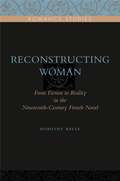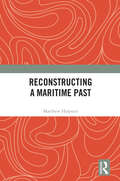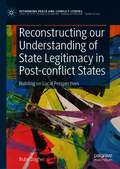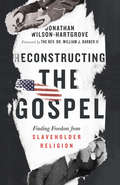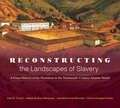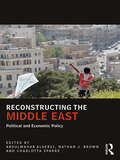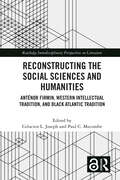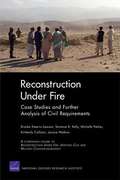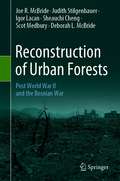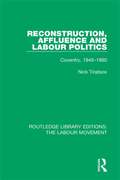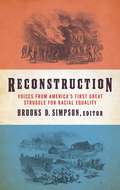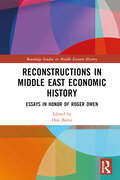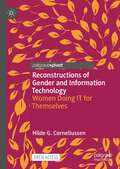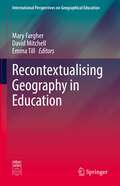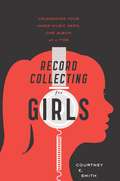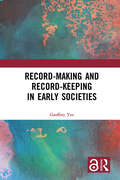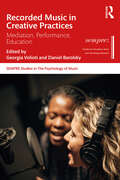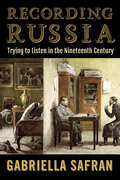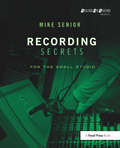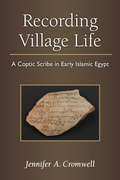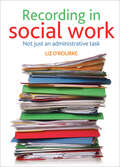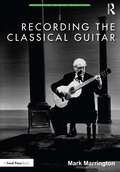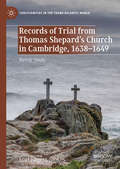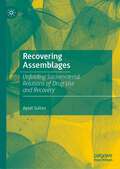- Table View
- List View
Reconstructing Woman: From Fiction to Reality in the Nineteenth-Century French Novel (Penn State Romance Studies #4)
by Dorothy KellyReconstructing Woman explores a scenario common to the works of four major French novelists of the nineteenth century: Balzac, Flaubert, Zola, and Villiers. In the texts of each author, a “new Pygmalion” (as Balzac calls one of his characters) turns away from a real woman he has loved or desired and prefers instead his artificial re-creation of her. All four authors also portray the possibility that this simulacrum, which replaces the woman, could become real. The central chapters examine this plot and its meanings in multiple texts of each author (with the exception of the chapter on Villiers, in which only “L’Eve future” is considered).The premise is that this shared scenario stems from the discovery in the nineteenth century that humans are transformable. Because scientific innovations play a major part in this discovery, Dorothy Kelly reviews some of the contributing trends that attracted one or more of the authors: mesmerism, dissection, transformism, and evolution, new understandings of human reproduction, spontaneous generation, puericulture, the experimental method. These ideas and practices provided the novelists with a scientific context in which controlling, changing, and creating human bodies became imaginable.At the same time, these authors explore the ways in which not only bodies but also identity can be made. In close readings, Kelly shows how these narratives reveal that linguistic and coded social structures shape human identity. Furthermore, through the representation of the power of language to do that shaping, the authors envision that their own texts would perform that function. The symbol of the reconstruction of woman thus embodies the fantasy and desire that their novels could create or transform both reality and their readers in quite literal ways. Through literary analyses, we can deduce from the texts just why this artificial creation is a woman.
Reconstructing a Maritime Past
by Matthew HarpsterReconstructing a Maritime Past argues that rather than applying geo-ethnic labels to shipwrecks to describe “Greek” or “Roman” seafaring, a more intriguing alternative emphasizes a maritime culture’s valorization of the Mediterranean Sea. Doing so creates new questions and research agendas to understand the past human relationship with the sea. This study makes this argument in three sections. Chapters 1 and 2, contrasting intellectual histories of maritime archaeological interpretive approaches common in Northern Europe and the Mediterranean, propose that the former perspective – which embodies contemporary and fluid perceptions of culture – is a better theoretical framework for future research. Chapters 3–5 re-interpret the corpus of submerged sites in the Mediterranean Sea with this approach, arguing that this dataset does not represent “Phoenician,” “Muslim,” or “Byzantine” seafaring, but the practices of a maritime culture. Key to this section is the author’s method that utilizes superimposed polygons to model patterns of maritime activity, generating centennial results at different scales. Having built the models of a maritime culture’s valorization of the Mediterranean Sea, Chapter 6 contains the first comparisons of these models to other datasets, questioning the relevance of textual media to understand maritime activity, while finding closer analogues with other archaeological corpora. By deconstructing interpretive methods in maritime archaeology, offering a new synthesizing interpretive approach that is scalable and decoupled from past perceptions, and critically examining the applicability of various media to illuminate the past maritime experience, this book will appeal to scholars at various stages of their careers.
Reconstructing our Understanding of State Legitimacy in Post-conflict States: Building on Local Perspectives (Rethinking Peace and Conflict Studies)
by Ruby DagherThis book reassesses performance legitimacy in the context of statebuilding and identifies the paradox between state institution building and state legitimacy by looking at the interplay between state legitimacy and leaders’ legitimacy The author reviews the significant weaknesses associated with the current measures of state legitimacy and uses this to demonstrate the incompatibility of these measurements with the reality faced by conflict and post-conflict countries. The author uses the Performance Legitimacy Theory of Transition framework to demonstrate the potential legitimacy paths that post-conflict countries can embark on and proposes a new approach for building state legitimacy in post-conflict countries. The author also introduces new indicators to measure performance legitimacy that also reflect its non-exclusive nature. Essential reading for students and researchers of Peace and Conflict Studies and especially of post-conflict development, peacebuilding, statebuilding, intervention, and democracy promotion. Also accessible to policy makers.
Reconstructing the Gospel: Finding Freedom from Slaveholder Religion
by Jonathan Wilson-Hartgrove2018 Foreword INDIES Book of the Year Award Finalists - Multicultural "I am a man torn in two. And the gospel I inherited is divided." Jonathan Wilson-Hartgrove grew up in the Bible Belt in the American South as a faithful church-going Christian. But he gradually came to realize that the gospel his Christianity proclaimed was not good news for everybody. The same Christianity that sang, "Amazing grace, how sweet the sound" also perpetuated racial injustice and white supremacy in the name of Jesus. His Christianity, he discovered, was the religion of the slaveholder. Just as Reconstruction after the Civil War worked to repair a desperately broken society, our compromised Christianity requires a spiritual reconstruction that undoes the injustices of the past. Wilson-Hartgrove traces his journey from the religion of the slaveholder to the Christianity of Christ. Reconstructing the gospel requires facing the pain of the past and present, from racial blindness to systemic abuses of power. Grappling seriously with troubling history and theology, Wilson-Hartgrove recovers the subversiveness of the gospel that sustained the church through centuries of slavery and oppression, from the civil rights era to the Black Lives Matter movement and beyond. When the gospel is reconstructed, freedom rings both for individuals and for society as a whole. Discover how Jesus continues to save us from ourselves and each other, to repair the breach and heal our land.
Reconstructing the Landscapes of Slavery: A Visual History of the Plantation in the Nineteenth-Century Atlantic World
by Dale W. Tomich Reinaldo Funes Monzote Carlos Venegas Fornias Rafael de Bivar MarqueseAssessing a unique collection of more than eighty images, this innovative study of visual culture reveals the productive organization of plantation landscapes in the nineteenth-century Atlantic world. These landscapes—from cotton fields in the Lower Mississippi Valley to sugar plantations in western Cuba and coffee plantations in Brazil's Paraiba Valley—demonstrate how the restructuring of the capitalist world economy led to the formation of new zones of commodity production. By extension, these environments radically transformed slave labor and the role such labor played in the expansion of the global economy.Artists and mapmakers documented in surprising detail how the physical organization of the landscape itself made possible the increased exploitation of enslaved labor. Reading these images today, one sees how technologies combined with evolving conceptions of plantation management that reduced enslaved workers to black bodies. Planter control of enslaved people's lives and labor maximized the production of each crop in a calculated system of production. Nature, too, was affected: the massive increase in the scale of production and new systems of cultivation increased the land's output. Responding to world economic conditions, the replication of slave-based commodity production became integral to the creation of mass markets for cotton, sugar, and coffee, which remain at the center of contemporary life.
Reconstructing the Middle East: Political and Economic Policy (UCLA Center for Middle East Development (CMED) series)
by Abdulwahab Alkebsi Charlotta Sparre Nathan J BrownIt is clear by now that the label ‘Arab Spring’ has proven too simplistic to describe the uprisings that upended the political order of the Arab world in late 2010. Brutal crackdowns and civil conflict in Syria, Libya, and Yemen dashed the hopes that peaceful democratic revolutions would sweep the region. In other countries, the departure of authoritarian?leaders led to many false starts without producing democratic conclusions. Societies that had appeared united in opposition suddenly seemed fractious. Youth?were once again banished to the political margins. ‘Reconstructing the Middle East’ examines the changes that happened within the region from 2010 and the long-term challenges and opportunities they present. Featuring the work of authors with a diversity of perspectives, most of whom hail from the region, it addresses key issues of political, economic and societal changes, the role of young people and of the international community. In addition, the book deals with the questions of both political and economic reform, and the intertwined nature of the two. Political reform that allows greater participation will fail to quell frustration if Arabs continue to feel that their job prospects are bleak. Similarly, Arabs will not accept economic reform that restores growth but continues to fence off the political sphere. This book offers a unique perspective on the uprisings by focusing on specific issue areas where change is needed, and offering a roadmap for the long road towards state building and new social contracts based on political inclusion, respect for pluralism, and sustained economic growth. As such, it will be a valuable resource for students and scholars of Middle East Politics, as well as those with an interest in the Arab Spring.
Reconstructing the Social Sciences and Humanities: Anténor Firmin, Western Intellectual Tradition, and Black Atlantic Tradition (Routledge Interdisciplinary Perspectives on Literature)
by Celucien L. JosephJoseph Anténor Firmin (1850–1911) was the reigning public intellectual and political critic in Haiti in the nineteenth century. He was the first “Black anthropologist” and “Black Egyptologist” to deconstruct the Western interpretation of global history and challenge the ideological construction of human nature and theories of knowledge in the Western social sciences and the humanities. As an anti-racist intellectual and cosmopolitan thinker, Firmin’s writings challenge Western ideas of the colonial subject, race achievement, and modernity’s imagination of a linear narrative based on the false premises of social evolution and development, colonial history and epistemology, and the intellectual evolution of the Aryan-White race. Firmin articulated an alternative way to study global historical trajectories, the political life, human societies and interactions, and the diplomatic relations and dynamics between the nations and the races. Reconstructing the Social Sciences and Humanities is the first full-length book devoted to Joseph Anténor Firmin. It reexamines the importance of his thought and legacy, and its relevance for the twenty-first century’s culture of humanism, and the continuing challenge of race and racism.
Reconstructing the Social Sciences and Humanities: Anténor Firmin, Western Intellectual Tradition, and Black Atlantic Tradition (Routledge Interdisciplinary Perspectives on Literature)
by Paul C. Mocombe Celucien L. JosephJoseph Anténor Firmin (1850–1911) was the reigning public intellectual and political critic in Haiti in the nineteenth century. He was the first “Black anthropologist” and “Black Egyptologist” to deconstruct the Western interpretation of global history and challenge the ideological construction of human nature and theories of knowledge in the Western social sciences and the humanities. As an anti-racist intellectual and cosmopolitan thinker, Firmin’s writings challenge Western ideas of the colonial subject, race achievement, and modernity’s imagination of a linear narrative based on the false premises of social evolution and development, colonial history and epistemology, and the intellectual evolution of the Aryan-White race. Firmin articulated an alternative way to study global historical trajectories, the political life, human societies and interactions, and the diplomatic relations and dynamics between the nations and the races.Reconstructing the Social Sciences and Humanities is the first full-length book devoted to Joseph Anténor Firmin. It reexamines the importance of his thought and legacy, and its relevance for the twenty-first century’s culture of humanism, and the continuing challenge of race and racism.
Reconstruction Under Fire: Case Studies and Further Analysis of Civil Requirements
by Jessica Watkins Terrence K. Kelly Kimberly Colloton Michelle Parker Brooke Stearns LawsonBuilding on a framework for integrating civil and military counterinsurgency (COIN) first presented in prior RAND research, this volume presents an approach to the civil component of counterinsurgency that builds on detailed background, context analysis, and threat analysis to identify and develop critical civil COIN activities and illustrates them with three case studies from Afghanistan, Iraq, and the Democratic Republic of the Congo.
Reconstruction of Urban Forests: Post World War II and the Bosnian War
by Joe R. McBride Scot Medbury Judith Stilgenbauer Igor Lacan Sheauchi Cheng Deborah L. McBrideThis book will address the destruction of urban forest in nine cities by bombing during World War II and the Bosnian War and their reconstruction in the post-war years. After reviewing the general objectives and results of aerial bombing, the book explores the effects of bombing and the reconstruction of urban forest in London, Coventry, Hamburg, Dresden, St. Petersburg, Stalingrad, Tokyo, Hiroshima, and Sarajevo. Sarajevo stands out among these cities because the destruction of its urban forest was the result of citizens cutting down trees for firewood during the siege of the city. Most of the cities studied developed plans for reconstruction either during or after the war. These plans often addressed the planning and re-establishment of the urban forest that had been destroyed. Urban planners often planned for infrastructure improvements such as new boulevards and parks where trees would be planted. After the war many of these plans were abandoned or significantly modified. Cost, resistance by property owners, control of reconstruction by authorities outside of the cities, and the lack of planting stock were factors contributing to the failure of many of the plans. Exceptions occurred in Hiroshima and Coventry where the destroyed cities became symbols of national reconstruction and every effort was made to redesign the destroyed portions of these cities as memorials to those who lost their lives and to demonstrate the rebirth of the cities. In several of the cities studied individual citizens undertook on their own the replanting of street and park trees. Their ingenuity, hard work, and dedication to trees in their cities was remarkable. A common factor limiting efforts to replant street and park trees was the lack of nursery stock. During and immediately after the wars nearly all nurseries that had supplied trees for city planting had been converted to vegetable gardens to produce food for the urban populations. The slow return to the production of trees for urban planting was a common factor in the time required in many cities to restore their street and park trees. There are lessons to be learned by urban planner, urban forester, and landscape architects from this book that will be useful in the future destruction of urban forest either by natural or man-made causes.
Reconstruction, Affluence and Labour Politics: Coventry, 1945-1960 (Routledge Library Editions: The Labour Movement #41)
by Nick TiratsooFirst published in 1990. Of all British cities, it is perhaps Coventry which has come to symbolise best the country's experience of World War II and the post-war period. An important engineering centre, Coventry immediately found itself geared up to produce armaments, a specialisation which inevitably brought considerable attention from the German Air Force, which in 1940 and 1941 destroyed much of the city centre. In the 1950s the city emerged as a boom town and as an exemplar of a new type of city, in step with the demands and aspirations of a modern, more democratic and equitable age. Yet this book is more than just a case study. By examining the experience of Coventry in particular, the author poses questions of significance to Britain's post-war development in general. Did the construction of the welfare state after 1945 inevitably hinder the country's long-term economic development? Can the rise and fall of the Labour Party's popularity be plotted in terms of increased popular affluence? By linking Coventry's specific history to wider questions, the book will be of interest to anyone who is concerned with Britain's post-war history.
Reconstruction: Voices from America's First Great Struggle for Racial Equality
by Brooks D. SimpsonThe violent aftermath of the Civil War comes to dramatic life in this sweeping new collection of firsthand writing There are few periods in American history more consquential but less understood than Reconstruction, the tumultuous twelve years after Appomattox, when the battered nation sought to reconstitute itself and confront the legacy of two centuries of slavery. This Library of America anthology brings together more than one hundred contemporary letters, diary entries, interviews, petitions, testimonies, and newspaper and magazine articles by well-known figures--Frederick Douglass, Frances Ellen Watkins Harper, Andrew Johnson, Thaddeus Stevens, Ulysses S. Grant, Elizabeth Cady Stanton, Mark Twain, Albion Tourgée--as well as by dozens of ordinary men and women, black and white, northern and southern, to tell the story of our nation's first attempt to achieve racial equality. Through their eyes readers experience the fierce contest between President Andrew Johnson and the Radical Republicans resulting in the nation's first presidential impeachment; the adoption of the revolutionary Fourteenth and Fifteenth Amendments; the first achievements of black political power; and the murderous terrorism of the Klan and other groups that, combined with northern weariness, indifference, and hostility, eventually resulted in the restoration of white supremacy in the South. Throughout, Americans confront the essential questions left unresolved by the defeat of secession: What system of labor would replace slavery, and what would become of the southern plantations? Would the war end in the restoration of a union of sovereign states, or in the creation of a truly national government? What would citizenship mean after emancipation, and what civil rights would the freed people gain? Would suffrage be extended to African American men, and to all women?
Reconstructions in Middle East Economic History: Essays in Honor of Roger Owen (Routledge Studies in Middle Eastern History)
by Don BabaiThis volume explores major theoretical and empirical themes in the study of the economic history of the Middle East.Despite the relative neglect of economic history in Middle Eastern studies, this book makes a case for its importance as a discipline of study. On the one hand, it shows promise in illuminating the economic base of historical trends and events; on the other, it can elucidate the historical foundations of economic continuity and change. The chapters employ an array of theoretical and methodological approaches and ultimately demonstrate how economics and history, along with political economy, complement each other in studying the Middle East. Among the substantive topics explored are the trajectories of the Arab Spring, institutional change and economic development in the early Ottoman Empire, the destructive effects of the reordering property rights in Iraq by the American-led occupation authority, the evolution of the political economy of the Islamic Republic of Iran, and the determinants of movements in the yields of Egyptian and Ottoman sovereign debt following political and economic crises in the 19th and early 20th centuries.The book will be of interest to scholars and students of economic history, political economy, and the Middle East.
Reconstructions of Gender and Information Technology: Women Doing IT for Themselves
by Hilde G. CorneliussenThis open access book explores what makes women decide to pursue a career in male-dominated fields such as information technology (IT). It reveals how women experience gendered stereotypes but also how they bypass, negotiate, and challenge such stereotypes, reconstructing gender-technology relations in the process. Using the example of Norway to illuminate this challenge in Western countries, the book includes a discussion of the “gender equality paradox”, where gender equality exists in parallel with gender segregation in fields such as IT. The discussion illustrates how the norm of gender equality in some cases hinders rather than promotes efforts to increase women’s participation in technology-related roles.
Recontextualising Geography in Education (International Perspectives on Geographical Education)
by David Mitchell Mary Fargher Emma TillIn this book international geography educators discuss the ways in which geographical knowledge is recontextualised in schools and consider effective approaches to facilitate, improve and advance geography education in research and practice. It addresses key topics in recontextualising geography such as the epistemic relationships between the university discipline and the school subject, designing and evaluating the geography curriculum, the role of students in the transformation of knowledge in the classroom and selecting and transforming geographical content knowledge for the primary school curriculum. At an international level, the contributors and editors bring together an advanced collection of research and discussion surrounding the opportunities and challenges of recontextualising geography in education. The book is of interest to geography educators internationally, including academics at universities, teachers in schools, and professional geographers with an interest in education.
Record Collecting For Girls: Unleashing Your Inner Music Nerd, One Album at a Time
by Courtney E. Smith“Record Collecting for Girls is an invitation for all of you stereophiles (who happen to be female), to make your own top-five lists, and then, armed and ready with the book’s fun facts, to argue their merits to the ever-present boys’ club of music snobs in your life.” —Sarahbeth Purcell, author of Love Is the Drug and This Is Not a Love SongYou never leave home without your iPod. You’re always on the lookout for new bands, and you have strong opinions when it comes to music debates, like Beatles vs. Stones. For years, you’ve listened to guys talk about all things music, but the female perspective has been missing. Until now. Drawing on her personal life as a music enthusiast, as well as her experience working at MTV and in radio, Courtney E. Smith explores what music can tell women about themselves—and the men in their lives. She takes on a range of topics, from the romantic soundtracks of Romeo and Juliet to the evolution of girl bands. She shares stories from her own life that shed light on the phenomenon of guilty pleasures and the incredible power of an Our Song. Along the way, she evaluates the essential role that music plays as we navigate life’s glorious victories and its soul-crushing defeats. Finally, here is a voice that speaks to women—because girls get their hearts broken and make mix tapes about it, too. “Courtney Smith has smarts and sass in spades. Her insights are as hilarious as they are thoughtful, and when you finish reading this book, you’ll feel like you just got home from a perfect night out with your best friend. And you’ll want to listen to Prince. At full volume.” —Megan Jasper, Executive Vice President, Sub Pop Records
Record-Making and Record-Keeping in Early Societies
by Geoffrey YeoRecord-Making and Record-Keeping in Early Societies provides a concise and up-to-date survey of early record-making and record-keeping practices across the world. It investigates the ways in which human activities have been recorded in different settings using different methods and technologies. Based on an in-depth analysis of literature from a wide range of disciplines, including prehistory, archaeology, Assyriology, Egyptology, and Chinese and Mesoamerican studies, the book reflects the latest and most relevant historical scholarship. Drawing upon the author’s experience as a practitioner and scholar of records and archives and his extensive knowledge of archival theory and practice, the book embeds its account of the beginnings of recording practices in a conceptual framework largely derived from archival science. Unique both in its breadth of coverage and in its distinctive perspective on early record-making and record-keeping, the book provides the only updated and synoptic overview of early recording practices available worldwide. Record-Making and Record-Keeping in Early Societies will be of interest to academics, researchers, and students engaged in the study of archival science, archival history, and the early history of human culture. The book will also appeal to practitioners of archives and records management interested in learning more about the origins of their profession.
Recorded Music in Creative Practices: Mediation, Performance, Education (ISSN)
by Daniel Barolsky Georgia VoliotiRecorded Music in Creative Practices: Mediation, Performance, Education brings new critical perspectives on recorded music research, artistic practice, and education into an active dialogue.Although scholars continue to engage keenly in the study of recordings and studio practices, less attention has been devoted to integrating these newer developments into music curricula. The fourteen chapters in this book bring fresh insight to the art and craft of recording music and offer readers ways to bridge research and pedagogy in diverse educational, academic, and music industry contexts. By exploring a wide range of genres, methods, and practices, this book aims to demonstrate how engaging with recordings, recording processes, material artefacts, studio spaces, and revised music history narratives means we can promote new understandings of the past, more creative performance in the present, and freer collaboration and experimentation inside and outside of the recording studio; enhance creative teaching and learning; inform and stimulate reform of the institutional processes and structures that frame musical training; and ultimately promote more diverse music curricula and communities of practice.This book will be of value to educators, researchers, practitioners (performers, composers, recordists), students in music and music-related fields, recording enthusiasts, and readers with a keen interest in the subject.
Recording Russia: Trying to Listen in the Nineteenth Century
by Gabriella SafranRecording Russia examines scenes of listening to "the people" across a variety of texts by Russian writers and European travelers to Russia. Gabriella Safran challenges readings of these works that essentialize Russia as a singular place where communication between the classes is consistently fraught, arguing instead that, as in the West, the sense of separation or connection between intellectuals and those they interviewed or observed is as much about technology and performance as politics and emotions. Nineteenth-century writers belonged to a distinctive media generation using new communication technologies—not bells, but mechanically produced paper, cataloguing systems, telegraphy, and stenography. Russian writers and European observers of Russia in this era described themselves and their characters as trying hard to listen to and record the laboring and emerging middle classes. They depicted scenes of listening as contests where one listener bests another; at times the contest is between two sides of the same person. They sometimes described Russia as an ideal testing ground for listening because of its extreme cold and silence. As the mid-century generation witnessed the social changes of the 1860s and 1870s, their listening scenes revealed increasing skepticism about the idea that anyone could accurately identify or record the unadulterated "voice of the people." Bringing together intellectual history and literary analysis and drawing on ideas from linguistic anthropology and sound and media studies, Recording Russia looks at how writers, folklorists, and linguists such as Turgenev, Dostoevsky, and Vladimir Dahl, as well as foreign visitors, thought about the possibilities and meanings of listening to and repeating other people's words.
Recording Secrets for the Small Studio (Sound On Sound Presents...)
by Mike SeniorDiscover how to achieve commercial-grade recordings, even in the smallest studios, by applying power-user techniques from the world's most successful producers. Recording Secrets for the Small Studio is an intensive training course specifically designed for small-studio enthusiasts who want a fast track to release-quality results. Based on the backroom strategies of more than 200 famous names, this thorough and down-to-earth guide leads you through a logical sequence of practical tasks to build your live-room skills progressively from the ground up. On the way, you'll unravel the mysteries of many specialist studio tactics and gain the confidence to tackle a full range of real-world recording situations. User-friendly explanations introduce technical concepts on a strictly need-to-know basis, while chapter summaries, assignments, and extensive online resources are perfect for school and college use. * Learn the fundamental principles of mic technique that you can apply in any recording scenario -- and how to avoid those rookie mistakes that all too often compromise the sonics of lower-budget productions. * Explore advanced techniques which help industry insiders maintain their competitive edge even under the most adverse conditions: creative phase manipulation, improvised acoustics tweaks, inventive monitoring workarounds, subtle psychological tricks... * Find out where you don't need to spend money, as well as how to make a limited budget really count. * Make the best use of limited equipment and session time, especially in situations where you're engineering and producing single-handed. * Pick up tricks and tips from celebrated engineers and producers across the stylistic spectrum, including Steve Albini, Roy Thomas Baker, Joe Barresi, Tchad Blake, Bruce Botnick, Joe Chiccarelli, Neil Dorfsman, Jack Douglas, Geoff Emerick, Paul Epworth, Humberto Gatica, Nigel Godrich, Andy Johns, Eddie Kramer, Kevin Killen, George Massenburg, Hugh Padgham, Alan Parsons, Jack Joseph Puig, Phil Ramone, Bob Rock, Elliott Scheiner, Al Schmitt, Bruce Swedien, Butch Vig, Tony Visconti, and many, many more...
Recording Village Life: A Coptic Scribe in Early Islamic Egypt
by Jennifer CromwellRecording Village Life presents a close study of over 140 Coptic texts written between 724–756 CE by a single scribe, Aristophanes son of Johannes, of the village Djeme in western Thebes. These texts, which focus primarily on taxation and property concerns, yield a wealth of knowledge about social and economic changes happening at both the community and country-wide levels during the early years of Islamic rule in Egypt. Additionally, they offer a fascinating picture of the scribe’s role within this world, illuminating both the practical aspects of his work and the social and professional connections with clients for whom he wrote legal documents. Papyrological analysis of Aristophanes’ documents, within the context of the textual record of the village, shows a new and divergent scribal practice that reflects broader trends among his contemporaries: Aristophanes was part of a larger, national system of administrative changes, enacted by the country’s Arab rulers in order to better control administrative practices and fiscal policies within the country. Yet Aristophanes’ dossier shows him not just as an administrator, revealing details about his life, his role in the community, and the elite networks within which he operated. This unique perspective provides new insights into both the micro-history of an individual’s experience of eighth-century Theban village life, and its reflection in the macro social, economic, and political trends in Egypt at this time. This book will prove valuable to scholars of late antique studies, papyrology, philology, early Islamic history, social and economic history, and Egyptology.
Recording in social work: Not just an administrative task
by Liz O'RourkeRecording is regarded by most social workers as a necessary evil. The research from which this book arises found that recording is a highly complex and demanding aspect of professional practice. Why has such a critical activity received so little attention, despite the concerns over social work records identified with successive inquiries into tragic deaths? This highly topical book explores the often conflicting demands on social workers as they record information on the case files, and will stimulate a long overdue debate as to how to achieve more effective recording in social work.
Recording the Classical Guitar (Perspectives on Music Production)
by Mark MarringtonRecording the Classical Guitar charts the evolution of classical guitar recording practice from the early twentieth century to the present day, encompassing the careers of many of the instrument’s most influential practitioners from acoustic era to the advent of the CD. A key focus is on the ways in which guitarists’ recorded repertoire programmes have shaped the identity of the instrument, particularly where national allegiances and musical aesthetics are concerned. The book also considers the ways in which changing approaches to recording practice have conditioned guitarists’ conceptions of the instrument’s ideal representation in recorded form and situates these in relation to the development of classical music recording aesthetics more generally. An important addition to the growing body of literature in the field of phonomusicology, the book will be of interest to guitarists and producers as well as students of record production and historians of classical music recording.
Records of Trial from Thomas Shepard’s Church in Cambridge, 1638–1649: Heroic Souls (Christianities in the Trans-Atlantic World)
by Lori Rogers-StokesThis book presents a revolutionary new reading of manuscript records left by puritan minister Thomas Shepard in Cambridge, Massachusetts that have been studied for decades as his on-the-spot recording of oral relations of faith delivered by candidates for church membership. This book proves that these records are not relations, but Shepard’s personal record of sessions of trial—meetings with candidates still working out their spiritual seeking. New transcriptions of the original manuscript records, and corresponding never-before-published writing by Shepard, dispel much of the confusion produced by the published transcriptions. Close-readings of the manuscripts, contrasted with the published transcriptions, set the stage for a new understanding of puritan spiritual preparation in Shepard’s Cambridge church. The book concludes with a challenge to the negative reading of the women’s records that is central to established scholarship, revealing their powerful, confident spiritual identities and voices.
Recovering Assemblages: Unfolding Sociomaterial Relations of Drug Use and Recovery
by Aysel SultanRecovering Assemblages offers an exciting new insight into the policies and practices of recovery and drug use bridging critical drug studies and the sociology of health and illness. The book investigates lived experiences of young people in Azerbaijan and Germany during their personal recovery from alcohol and other drug use and shows the contingency of 'real' experiences. The sociomaterial and ontological analyses unfold the interrelation of practices, spaces, bodies, and affects in experiencing recovery both within and outside of various treatment facilities. The book will appeal to a range of scholars, postgraduates, and undergraduates engaged in critical, methodological, and empirical studies of recovery, drug use, and policy.
